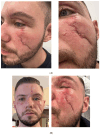Application of Standardized Rosa damascena Stem Cell-Derived Exosomes in Dermatological Wound Healing and Scar Management: A Retrospective Case-Series Study with Long-Term Outcome Assessment
- PMID: 40733118
- PMCID: PMC12300614
- DOI: 10.3390/pharmaceutics17070910
Application of Standardized Rosa damascena Stem Cell-Derived Exosomes in Dermatological Wound Healing and Scar Management: A Retrospective Case-Series Study with Long-Term Outcome Assessment
Abstract
Background: Scar formation and impaired wound healing represent significant challenges in dermatology and aesthetic medicine, with limited effective treatment options currently available. Objectives: To evaluate the efficacy and long-term outcomes of Damask rose stem-cell-derived exosome (RSCE) therapy in the management of diverse dermatological conditions, including traumatic wounds, surgical scars, and atrophic acne scars. Methods: We conducted a case series study from June 2023 to November 2024, documenting four cases with different types of skin damage treated with lyophilized RSCE products. Treatment protocols included a variety of delivery methods such as topical application, microneedling, and post-procedure care. Follow-up assessments were performed at intervals ranging from 7 days to 10 months. Results: All patients demonstrated significant improvements in scar appearance, skin elasticity, hydration, and overall tissue quality. In traumatic facial injury, RSCE therapy facilitated reduction in scar contracture and improved functional outcomes. For atrophic acne scars, comparative treatment of facial sides showed enhanced results with RSCE addition. Acute wounds exhibited accelerated healing with reduced inflammation, while chronic wounds demonstrated improved epithelialization and long-term scar quality. Conclusions: This case series provides preliminary evidence suggesting that RSCE therapy may offer significant benefits in wound healing and scar management. The observed improvements in tissue regeneration, inflammatory modulation, and long-term aesthetic outcomes warrant further investigation through controlled clinical trials.
Keywords: atrophic acne scars; damask rose stem cells; exosome therapy; exosomes; extracellular vesicles; plant-derived exosome-like nanovesicles; post-surgical scars; regenerative dermatology; rose stem cell-derived exosomes; scar remodeling; skin regeneration; wound healing.
Conflict of interest statement
The authors declare no conflicts of interest.
Figures







Similar articles
-
Interventions for acne scars.Cochrane Database Syst Rev. 2016 Apr 3;4(4):CD011946. doi: 10.1002/14651858.CD011946.pub2. Cochrane Database Syst Rev. 2016. PMID: 27038134 Free PMC article.
-
Laser therapy for treating hypertrophic and keloid scars.Cochrane Database Syst Rev. 2022 Sep 26;9(9):CD011642. doi: 10.1002/14651858.CD011642.pub2. Cochrane Database Syst Rev. 2022. PMID: 36161591 Free PMC article.
-
Pressure-garment therapy for preventing hypertrophic scarring after burn injury.Cochrane Database Syst Rev. 2024 Jan 8;1(1):CD013530. doi: 10.1002/14651858.CD013530.pub2. Cochrane Database Syst Rev. 2024. PMID: 38189494 Free PMC article.
-
Negative pressure wound therapy for open traumatic wounds.Cochrane Database Syst Rev. 2018 Jul 3;7(7):CD012522. doi: 10.1002/14651858.CD012522.pub2. Cochrane Database Syst Rev. 2018. PMID: 29969521 Free PMC article.
-
Silicone gel sheeting for treating keloid scars.Cochrane Database Syst Rev. 2023 Jan 3;1(1):CD013878. doi: 10.1002/14651858.CD013878.pub2. Cochrane Database Syst Rev. 2023. PMID: 36594476 Free PMC article.
References
LinkOut - more resources
Full Text Sources

